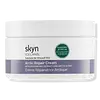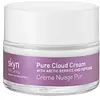What's inside
What's inside
 Key Ingredients
Key Ingredients

 Benefits
Benefits

 Concerns
Concerns

 Ingredients Side-by-side
Ingredients Side-by-side

Water
Skin ConditioningCaprylic/Capric Triglyceride
MaskingGlycerin
HumectantSqualane
EmollientGlyceryl Stearate Citrate
EmollientGlyceryl Stearate Se
EmulsifyingCetearyl Alcohol
EmollientPropanediol
SolventAngelica Archangelica Root Water
Skin ConditioningAvena Sativa Kernel Flour
AbrasiveChondrus Crispus Extract
Skin ConditioningJojoba Oil/Macadamia Seed Oil Esters
Skin ConditioningOxycoccus Palustris Seed Oil
AntioxidantRubus Chamaemorus Seed Oil
Skin ConditioningLaminaria Saccharina Extract
Skin ProtectingSqualene
EmollientPentylene Glycol
Skin ConditioningEmblica Officinalis Fruit Extract
Skin ConditioningLinoleic Acid
CleansingLinolenic Acid
CleansingSodium PCA
HumectantVaccinium Myrtillus Seed Oil
Skin ConditioningSodium Hyaluronate
HumectantBuddleja Davidii Extract
Skin ConditioningThymus Vulgaris Flower/Leaf Extract
MaskingSimmondsia Chinensis Seed Oil
EmollientGinkgo Biloba Leaf Extract
Skin ConditioningGlycosphingolipids
EmollientRosmarinus Officinalis Leaf Extract
AntimicrobialHelianthus Annuus Seed Oil
EmollientEthylhexylglycerin
Skin ConditioningArginine
MaskingPhytosterols
Skin ConditioningTocopherol
AntioxidantTocopheryl Acetate
AntioxidantCaprylyl Glycol
EmollientPhenoxyethanol
PreservativeXanthan Gum
EmulsifyingAcrylates/C10-30 Alkyl Acrylate Crosspolymer
Emulsion StabilisingPhytosteryl Macadamiate
Skin ConditioningPerfluorodecalin
Skin ConditioningHydroxyphenyl Propamidobenzoic Acid
Skin ConditioningSorbic Acid
PreservativeSucrose Palmitate
EmollientButylene Glycol
HumectantCitric Acid
BufferingSodium Hydroxide
BufferingPotassium Sorbate
PreservativeSodium Benzoate
MaskingWater, Caprylic/Capric Triglyceride, Glycerin, Squalane, Glyceryl Stearate Citrate, Glyceryl Stearate Se, Cetearyl Alcohol, Propanediol, Angelica Archangelica Root Water, Avena Sativa Kernel Flour, Chondrus Crispus Extract, Jojoba Oil/Macadamia Seed Oil Esters, Oxycoccus Palustris Seed Oil, Rubus Chamaemorus Seed Oil, Laminaria Saccharina Extract, Squalene, Pentylene Glycol, Emblica Officinalis Fruit Extract, Linoleic Acid, Linolenic Acid, Sodium PCA, Vaccinium Myrtillus Seed Oil, Sodium Hyaluronate, Buddleja Davidii Extract, Thymus Vulgaris Flower/Leaf Extract, Simmondsia Chinensis Seed Oil, Ginkgo Biloba Leaf Extract, Glycosphingolipids, Rosmarinus Officinalis Leaf Extract, Helianthus Annuus Seed Oil, Ethylhexylglycerin, Arginine, Phytosterols, Tocopherol, Tocopheryl Acetate, Caprylyl Glycol, Phenoxyethanol, Xanthan Gum, Acrylates/C10-30 Alkyl Acrylate Crosspolymer, Phytosteryl Macadamiate, Perfluorodecalin, Hydroxyphenyl Propamidobenzoic Acid, Sorbic Acid, Sucrose Palmitate, Butylene Glycol, Citric Acid, Sodium Hydroxide, Potassium Sorbate, Sodium Benzoate
Water
Skin ConditioningHydrogenated Didecene
Skin ConditioningButylene Glycol
HumectantGlyceryl Stearate
EmollientBisabolol
MaskingPrunus Amygdalus Dulcis Oil
Skin ConditioningSodium Hyaluronate
HumectantHydrolyzed Rice Protein
Skin ConditioningAngelica Archangelica Root Water
Skin ConditioningAcetyl Dipeptide-1 Cetyl Ester
Skin ConditioningLeuconostoc/Radish Root Ferment Filtrate
AntimicrobialCamellia Oleifera Leaf Extract
AstringentGlycerin
HumectantGlyceryl Caprylate
EmollientRubus Chamaemorus Seed Oil
Skin ConditioningSimmondsia Chinensis Seed Oil
EmollientAcrylates/C10-30 Alkyl Acrylate Crosspolymer
Emulsion StabilisingCanola Oil
EmollientCetyl Alcohol
EmollientCetyl Ricinoleate
EmollientSorbitan Stearate
EmulsifyingStearic Acid
CleansingCitrus Grandis Peel Oil
MaskingTriceteareth-4 Phosphate
EmulsifyingSilica
AbrasiveZea Mays Starch
AbsorbentGlyceryl Undecylenate
EmollientLaureth-3
EmulsifyingSodium Hydroxide
BufferingAloe Barbadensis Leaf Juice
Skin ConditioningHydroxyethylcellulose
Emulsion StabilisingPerfluorodecalin
Skin ConditioningPotassium Sorbate
PreservativeSodium Polyacrylate
AbsorbentEthylhexyl Stearate
EmollientSodium Benzoate
MaskingBuddleja Davidii Extract
Skin ConditioningGlycosphingolipids
EmollientSucrose Palmitate
EmollientThymus Vulgaris Flower/Leaf Extract
MaskingTrideceth-6
EmulsifyingXanthan Gum
EmulsifyingBiotin
AntiseborrhoeicWater, Hydrogenated Didecene, Butylene Glycol, Glyceryl Stearate, Bisabolol, Prunus Amygdalus Dulcis Oil, Sodium Hyaluronate, Hydrolyzed Rice Protein, Angelica Archangelica Root Water, Acetyl Dipeptide-1 Cetyl Ester, Leuconostoc/Radish Root Ferment Filtrate, Camellia Oleifera Leaf Extract, Glycerin, Glyceryl Caprylate, Rubus Chamaemorus Seed Oil, Simmondsia Chinensis Seed Oil, Acrylates/C10-30 Alkyl Acrylate Crosspolymer, Canola Oil, Cetyl Alcohol, Cetyl Ricinoleate, Sorbitan Stearate, Stearic Acid, Citrus Grandis Peel Oil, Triceteareth-4 Phosphate, Silica, Zea Mays Starch, Glyceryl Undecylenate, Laureth-3, Sodium Hydroxide, Aloe Barbadensis Leaf Juice, Hydroxyethylcellulose, Perfluorodecalin, Potassium Sorbate, Sodium Polyacrylate, Ethylhexyl Stearate, Sodium Benzoate, Buddleja Davidii Extract, Glycosphingolipids, Sucrose Palmitate, Thymus Vulgaris Flower/Leaf Extract, Trideceth-6, Xanthan Gum, Biotin
 Reviews
Reviews

Ingredients Explained
These ingredients are found in both products.
Ingredients higher up in an ingredient list are typically present in a larger amount.
Acrylates/C10-30 Alkyl Acrylate Crosspolymer is a synthetic polymer. It is used to thicken and improve the texture of products. Due to its properties, it can prevent water and oil ingredients from separating.
We don't have a description for Angelica Archangelica Root Water yet.
Buddleja Davidii Extract is native to China and Japan. It is also known as the Butterfly Bush as it provides food for butterflies.
This ingredient is rich in antioxidants.
Butylene Glycol (or BG) is used within cosmetic products for a few different reasons:
Overall, Butylene Glycol is a safe and well-rounded ingredient that works well with other ingredients.
Though this ingredient works well with most skin types, some people with sensitive skin may experience a reaction such as allergic rashes, closed comedones, or itchiness.
Learn more about Butylene GlycolGlycerin is already naturally found in your skin. It helps moisturize and protect your skin.
A study from 2016 found glycerin to be more effective as a humectant than AHAs and hyaluronic acid.
As a humectant, it helps the skin stay hydrated by pulling moisture to your skin. The low molecular weight of glycerin allows it to pull moisture into the deeper layers of your skin.
Hydrated skin improves your skin barrier; Your skin barrier helps protect against irritants and bacteria.
Glycerin has also been found to have antimicrobial and antiviral properties. Due to these properties, glycerin is often used in wound and burn treatments.
In cosmetics, glycerin is usually derived from plants such as soybean or palm. However, it can also be sourced from animals, such as tallow or animal fat.
This ingredient is organic, colorless, odorless, and non-toxic.
Glycerin is the name for this ingredient in American English. British English uses Glycerol/Glycerine.
Learn more about GlycerinGlycosphingolipids are naturally found in the cell membranes of organisms. In animals, they are the major glycolipids found.
Glyolipids help ensure the stability of cell membranes. They also help with cellular recognition, such as allowing cells to form tissues in skin.
We don't have a description for Perfluorodecalin yet.
Potassium Sorbate is a preservative used to prevent yeast and mold in products. It is commonly found in both cosmetic and food products.
This ingredient comes from potassium salt derived from sorbic acid. Sorbic acid is a natural antibiotic and effective against fungus.
Both potassium sorbate and sorbic acid can be found in baked goods, cheeses, dried meats, dried fruit, ice cream, pickles, wine, yogurt, and more.
You'll often find this ingredient used with other preservatives.
Learn more about Potassium SorbateCloudberry seed oil is rich in vitamin C, citric acid, malic acid, vitamin C, and beta-carotene.
This oil comes from the seeds of the desert shrub called Jojoba. It is more commonly known as jojoba oil, a non-comedogenic oil.
Jojoba oil does not contain fragrance and has many fatty-acids, making it a great soothing ingredient.
It also contains Vitamin E, a great moisturizing ingredient. Vitamin E is also an antioxidant and protects your skin against oxidative damage.
This ingredient humectant properties, meaning it helps draw moisture from the air. This helps keep your skin hydrated.
While jojoba has antibacterial properties, it is only able to kill some strains of bacteria.
Studies also show it helps in wound healing. In fact, Indigenous cultures have used jojoba as a moisturizer and to help treat burns for centuries.
Fun fact: Jojoba oil similar to natural human skin sebum, so it has a great effect on dry skin. It is also promising with helping to regulate sebum production.
Due to its fatty acid content, Jojoba oil may not be fungal acne safe. We recommend speaking with a professional if you have any concerns.
Learn more about Simmondsia Chinensis Seed OilSodium Benzoate is a preservative. It's used in both cosmetic and food products to inhibit the growth of mold and bacteria. It is typically produced synthetically.
Both the US FDA and EU Health Committee have approved the use of sodium benzoate. In the US, levels of 0.1% (of the total product) are allowed.
Sodium benzoate works as a preservative by inhibiting the growth of bacteria inside of cells. It prevents the cell from fermenting a type of sugar using an enzyme called phosphofructokinase.
It is the salt of benzoic acid. Foods containing sodium benzoate include soda, salad dressings, condiments, fruit juices, wines, and snack foods.
Studies for using ascorbic acid and sodium benzoate in cosmetics are lacking, especially in skincare routines with multiple steps.
We always recommend speaking with a professional, such as a dermatologist, if you have any concerns.
Learn more about Sodium BenzoateSodium Hyaluronate is hyaluronic acid's salt form. It is commonly derived from the sodium salt of hyaluronic acid.
Like hyaluronic acid, it is great at holding water and acts as a humectant. This makes it a great skin hydrating ingredient.
Sodium Hyaluronate is naturally occurring in our bodies and is mostly found in eye fluid and joints.
These are some other common types of Hyaluronic Acid:
Learn more about Sodium HyaluronateSodium Hydroxide is also known as lye or caustic soda. It is used to adjust the pH of products; many ingredients require a specific pH to be effective.
In small amounts, sodium hydroxide is considered safe to use. However, large amounts may cause chemical burns due to its high alkaline.
Your skin has a natural pH and acid mantle. This acid mantle helps prevent harmful bacteria from breaking through. The acid mantle also helps keep your skin hydrated.
"Alkaline" refers to a high pH level. A low pH level would be considered acidic.
Learn more about Sodium HydroxideWe don't have a description for Sucrose Palmitate yet.
We don't have a description for Thymus Vulgaris Flower/Leaf Extract yet.
Water. It's the most common cosmetic ingredient of all. You'll usually see it at the top of ingredient lists, meaning that it makes up the largest part of the product.
So why is it so popular? Water most often acts as a solvent - this means that it helps dissolve other ingredients into the formulation.
You'll also recognize water as that liquid we all need to stay alive. If you see this, drink a glass of water. Stay hydrated!
Learn more about WaterXanthan gum is used as a stabilizer and thickener within cosmetic products. It helps give products a sticky, thick feeling - preventing them from being too runny.
On the technical side of things, xanthan gum is a polysaccharide - a combination consisting of multiple sugar molecules bonded together.
Xanthan gum is a pretty common and great ingredient. It is a natural, non-toxic, non-irritating ingredient that is also commonly used in food products.
Learn more about Xanthan Gum